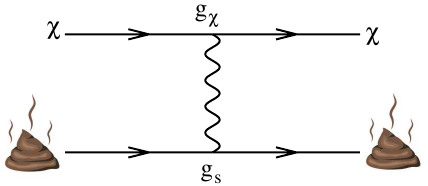arXiv Fool's Day 2024
Posted by David Zaslavsky on — CommentsI have been a bit of a slacker for the past year, but April is here, which means it’s time for another update to my “asymptotically comprehensive” list of April 1 arXiv joke papers!
This year I found 20 new papers, which the biggest addition yet. On one hand, congratulations researchers! On the other hand, that means a lot of work for me to look over them all — and I can’t even slack off because so many of them are really good.

I couldn’t resist starting with the figure on the right, from Scatophobic Dark Matter brought to my attention by Jim Cline. I mean, look at that cute little pile of poo, so innocent and honest. Unfortunately the paper says we’re going to have a hard time finding experimental confirmation: “…no direct detection signals will be observed before the demise of civilization.” And probably also because it’s stinky, although maybe the experimentalists are used to that. (I kid, I kid)
Explanations for dark matter are a perennial topic of speculation, though, and the scatophobic theory has competition this year: a proposal that dark matter might be made of souls. Souls have long been known to be nearly undetectable, after all, and this proposal even has some preliminary phenomenological support from a study exactly one year earlier (funny timing, that). I commend the authors for heading off criticism based on the anthropic principle by not limiting their analysis to human souls. Though, food for thought… if subatomic particles have souls, but all electrons are the same, do they get into heaven?
Personally I’m still partial to prior work suggesting that dark matter is made of poo. But I’m glad, this means the dark matter debate is far from over. I wonder what will be proposed as a candidate next?
Dark matter also makes an appearance in Multi-Messenger Astrology, but here the spotlight is on other better-understood phonomena: gamma rays, cosmic rays, neutrinos, and gravitational ways. Did you know the presence of GRBs in your astrological sign might make you prone to anger? I mean, who’s to say they’re not? Meanwhile, dark matter indicates people who rarely interact with others, which clearly explains why I’m sitting here writing this post at 2 AM instead of having a life. Check out the paper for more surprising revelations about what previously invisible secrets might be in your horoscope!
Solar eclipses are referenced from a couple papers, unsurprisingly because of the upcoming North American total eclipse. (That’s real, by the way!) Vulcan: Retreading a Tired Hypothesis with the 2024 Total Solar Eclipse calls back to the hypothetical (or is it?) planet Vulcan. There were a few reported observations of something that might have been Vulcan up to the 1870s, and then… nothing. What happened? Could it have been destroyed? Find out in summer 2009)… oh wait. In this case the paper proposes that Vulcan might have landed on a highly inclined orbit, and the upcoming eclipse would be the perfect opportunity to search for it. Just make sure to squint really hard.
Continuing on the eclipse theme, Species Syzygy: Which Animal Has Seen the Most Total Solar Eclipses? addresses exactly the question you’d expect from the title: in the entire course of its existence on Earth, how many times has any solar eclipse been experienced by members of a given species? The analysis in this one is actually quite well done, I was impressed. 4 stars, would approve for publication. It turns out that horseshoe crabs have a commanding lead over humans, but we might be able to catch up in less than 10 million years (yay).
Meanwhile, we also have another paper citing Star Trek which analyzes the effect of the starship Voyager on planetary rings. Voyager really seems to like orbiting planets with rings. But it turns out parking a starship near a ring system can wreak havoc on it, sending little rocks flying about and causing the ring to puff up to as much as double its original thickness, which could easily be noticed on the planet. This sets the stage for some severe violations of the Prime Directive, definitely never mentioned in the show, but you know where they are mentioned? This paper.
In a callback to last year’s post, one of this year’s papers announces a new Python package called exo-puppies.
The paper may be a joke, but the package is very real, and so are the puppy plots!
On top of that, much respect to the paper’s goal of calling attention to mental health issues and abuse of power in academic environments.
There’s a nice non-jokey summary of these issues in the last section of the paper; go have a look!
And speaking of callbacks: did you know that the very first two arXiv joke papers (on my list, at least) came from two groups of the University of Arizona’s astronomy department throwing shade at each other? If you read another one of this year’s joke papers, On the Superiority of the University of Arizona’s Physics Club, you will! Watch your back astro, the physicists are coming. (shh don’t tell the biologists)
If you like what you see here, there are more; check out the whole list! I haven’t even gotten to go through all the good ones (like this one by Winter, Winter, Winter, and Winter… one guess what it’s about). May these bring much enjoyment at any time of the year. And as usual, please let me know of any papers I’ve missed.